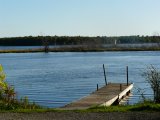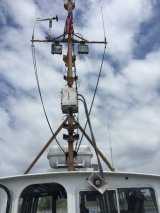EPA Research in Wisconsin
EPA researchers are working hard to protect communities across the nation. Learn about some of the work EPA researchers are doing in Wisconsin.
- Air Sensor Loan Programs: Promoting Air Quality Education by Bringing Sensors to You!
- EPA Researchers Assess the Health of the Coastal Waters of the Great Lakes
- EPA Researchers Help Water Systems Keep Lead out of Drinking Water
- Study Assesses Long-Term Capabilities of Air Sensors
- Response to Ricin Contamination
- Revealing the Complicated Nature of Tap Water Lead Contamination
- Preserving and Promoting the Cultural Significance of Kingsbury Bay and Grassy Point
- Chemical Safety Research Collaborators Provide Research Review
- Tackling the Ozone Issue on Lake Michigan’s Shores
- Predicting Water Quality at Beaches
- Pickle Pond Restoration
- EPA Researchers Explore Brownfield Revitalization’s Effects on Communities
- Staging a Comeback Along the St. Louis River
- Helping Community Drinking Water Systems Find Cost-Effective Solutions to Treatment Challenges
For more EPA work, see EPA in Wisconsin.
Air Sensor Loan Programs
As interest in local air quality increases, so does the demand for air sensors — the smaller, lower cost, non-regulatory technologies that measure air quality. However, air sensors are not always accessible to everyone. EPA has expanded its air sensor loan program in Region 5 to include more sensors and locations in Minnesota, Ohio, and Wisconsin. Read Air Sensor Loan Programs: Promoting Air Quality Education by Bringing Sensors to You!
EPA Researchers Assess the Health of the Coastal Waters of the Great Lakes
In 2020, EPA researchers conducted the National Coastal Condition Assessment of the nearshore waters of the Great Lakes. Researchers collected additional samples from Green Bay to assess water quality in Lake Michigan. Green Bay is of special interest to Wisconsin and Michigan because of the historical impacts of industrial pollution and agricultural runoff from its local watershed. Data from the assessment will help states decide how to protect areas in good condition and restore areas that have suffered environmental damage. Read EPA Researchers Collaborate with States to Assess the Health of the Coastal Waters of the Great Lakes.
EPA Researchers Help Water Systems Keep Lead out of Drinking Water
If a water system has lead service lines, limiting corrosion is a necessary step to reduce lead exposure from drinking water. EPA and other scientists use predictive solubility models to try and help drinking water systems pick the right corrosion control treatment that fits their system’s individual needs. EPA researchers looked at how well these models were predicting what is happening in the real world by using data and real-world pieces of piping from EPA’s Region 5 — comprised of Minnesota, Wisconsin, Michigan, Illinois, Indiana, and Ohio. Read EPA Researchers Help Water Systems Keep Lead out of Drinking Water.
Study Assesses Long-Term Capabilities of Air Sensors
In 2019, EPA began the Long-Term Performance Project to tackle questions about long-term use of air sensors, and their performance and capabilities. Researchers will evaluate six models of commercial air sensors, placing them in seven locations with diverse climates and air quality conditions across the country, including in Milwaukee. Read Study Assesses Long-Term Capabilities of Air Sensors.
Response to Ricin Contamination
Ricin is a deadly biological toxin that is easily produced from castor beans, making it one of the most worrisome biological threat agents. In response to an increase in ricin incidents occurring between 2013-2019, including incidents in Wisconsin, EPA researchers in the Office of Research and Development developed innovative solutions that led to significantly shortened response times and decreased costs and resources required for ricin incidents. This work provided the federal government with important new capabilities for helping states and local communities respond to ricin incidents.
Revealing the Complicated Nature of Tap Water Lead Contamination
Lead can contaminate drinking water as the water moves through pipes with lead in them. In some cases, lead levels in drinking water can remain high even after the pipes in the system have been replaced. EPA researchers worked with the city of Madison, Wisconsin, to determine why elevated lead levels can persist for so long. Read Revealing the Complicated Nature of Tap Water Lead Contamination: A Madison, Wisconsin, Case Study.
Preserving and Promoting the Cultural Significance of Kingsbury Bay and Grassy Point

EPA and partners restored sites along the St. Louis River that have long suffered from pollution. These areas have traditionally provided space for spiritual reflection and other tribal uses for the Native American communities in the area. EPA researchers are working with Fond du Lac Band members so that Tribal resources, culturally significant places, and indigenous knowledge are incorporated into recommendations for restoration plans. Read Helping Preserve and Promote the Cultural Significance of Kingsbury Bay and Grassy Point.
Chemical Safety Research Collaborators Provide Research Review
EPA is working with grantees to develop predictive toxicology tools. This work includes research on virtual tissue models, sometimes referred to as “Organs on-a-chip,” provide a pathway for the development of new prediction techniques. They also have the potential to reduce dependence on animal study data and contribute to faster chemical risk assessments. To highlight research progress and share information, EPA hosted their 3rd Annual STAR Organotypic Culture Models for Predictive Toxicology Research Centers Progress Review in May 2018. The two-day conference enabled robust discussion between interdisciplinary scientists and trainees within EPA and at institutions, including the University of Wisconsin-Madison. Read Developing Organs On-a-Chip: Chemical Safety Research Collaborators Provide Research Review.

Tackling the Ozone Issue on Lake Michigan’s Shores
EPA scientists collaborated with multiple agencies for the Lake Michigan Ozone Study. This field study aimed to better understanding ozone chemistry and meteorology along the Wisconsin-Illinois Lake Michigan shoreline using a combination of aircraft, ground-based, and ship-based measurements. Read By Air, Land and Sea: Tackling the Ozone Issue on Lake Michigan’s Shores.
Predicting Water Quality at Beaches
To protect public health, beach managers need to continually assess the level of potentially harmful microbes in the water. Traditional culture-based testing methods can take 24 hours to get results – preventing same-day, proactive beach closures and leaving many recreational swimmers open to sickness or infection, or potentially close a beach needlessly and incur economic losses. ORD's Virtual Beach software offers a solution. Virtual Beach facilitates efforts to support the local economy while protecting the health of residents. Virtual Beach is used to assist in advisory issuances in the Great Lakes states and to forecast water conditions in numerous locations in Illinois, Indiana, Maryland, Michigan, Minnesota, New York, Ohio, Pennsylvania, Rhode Island, South Carolina, and Wisconsin.
Pickle Pond Restoration
The origin of Pickle Pond in Superior, Wisconsin dates back to the 1800s when a railroad construction project cut it off from the rest of Barker’s Bay. Isolated and sheltered from the larger bay, it became a unique area in the lower estuary that provides a habitat to both native plants and wildlife. However, it did not endure as a healthy ecosystem. Over the years, contamination from diverted sewage and runoff from the increasingly urban surrounding watershed have significantly reduce the water quality of Pickle Pond. Researchers from EPA’s Great Lakes Toxicology and Exposure Laboratory study the benefits of coastal wetlands restoration in the urban Great Lakes Estuary, including Pickle Pond which is considered an Area of Concern. In early 2022, EPA researchers began collaborating with the City of Superior and the Wisconsin Department of Natural Resources to design a project plan for restoration.
EPA Researchers Explore Brownfield Revitalization’s Effects on Communities
Brownfields are underused properties where expansion, reuse, or redevelopment is complicated due to the presence or potential presence of a hazardous substance, pollutant, or contaminant. Cleaning up these sites offers several benefits to the community, but there are also concerns that some residents may be impacted in unforeseen ways. EPA researchers collected and analyzed neighborhood-level data in four neighborhood areas with brownfields, including Milwaukee, and explored the impacts of brownfields cleanup and reuse. Read EPA Researchers Explore Brownfield Revitalization’s Effects on Communities.
Staging a Comeback Along the St. Louis River
EPA researchers and a host of partners have been working to restore the St. Louis River estuary and help local communities reap the full benefits of a clean, healthy environment. Their work is already making improvements in water quality. Researchers shared their findings at the Seventh Annual St. Louis River Summit in mid-March on the campus of the University of Wisconsin, Superior. Read Staging a Comeback Along the St. Louis River.
Helping Community Drinking Water Systems Find Cost-Effective Solutions to Treatment Challenges
Emerging contaminants, such as per- and polyfluoroalkyl substances (PFAS), are challenging to drinking water systems across the country. Effective treatment for emerging contaminants can be unknown, difficult, and extremely costly. Working with the state of Wisconsin, EPA researchers are providing technical assistance to three large community water systems with PFAS concerns to help them identify optimal, cost-effective treatment methods and optimize the long-term operation of their chosen technology. These efforts will also be used to develop best practices and performance and cost estimate tools so water utilities across the country can make informed treatment and operational choices. Read Technical Assistance for Treatment Options to Remove Emerging Contaminants.
